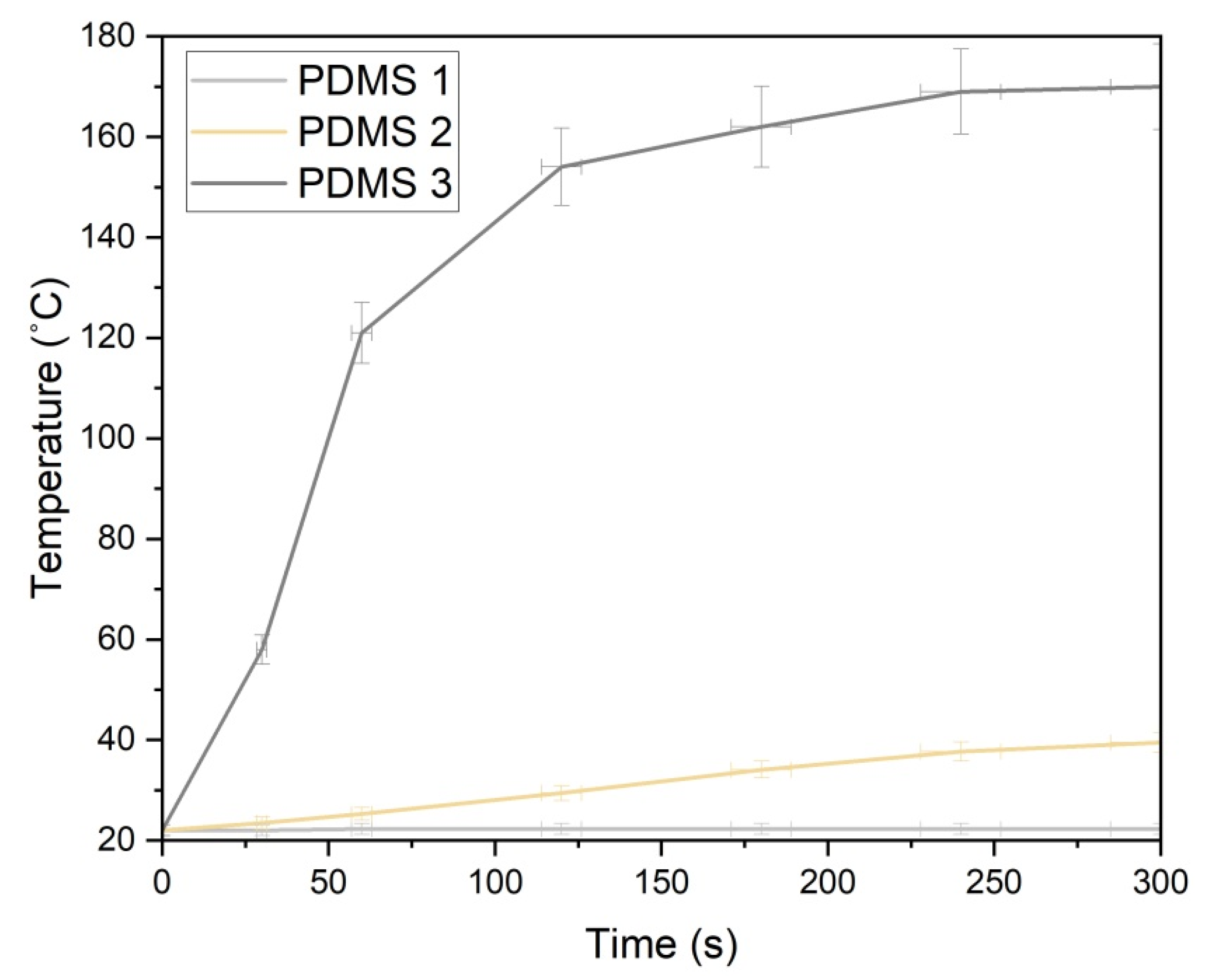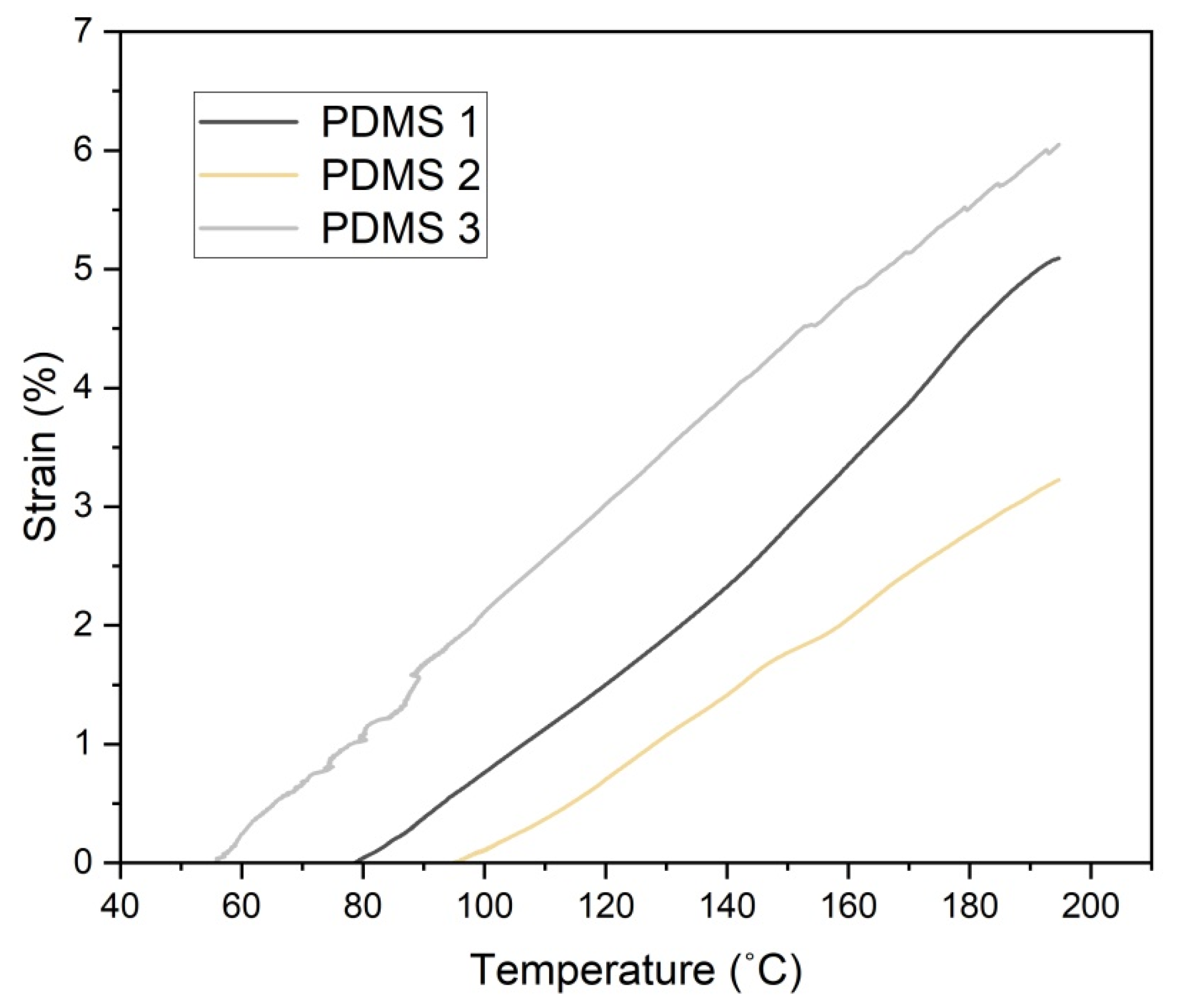The Influence of Self-Heating Iron on the Thermal, Mechanical, and Swelling Properties of PDMS Composites for Organic Solvents Removal
Abstract
:1. Introduction
2. Materials and Methods
2.1. Materials
2.2. Fabrication of PDMS Composites Using the Magnetic Induction Heating System
2.3. Characterizations
3. Results and Discussion
3.1. Fabrication of the PDMS Composites
3.2. Heating Efficiency
3.3. Thermal Stability
3.4. SEM Analysis
3.5. Strain–Temperature Properties
3.6. Swelling Behavior
4. Conclusions
Author Contributions
Funding
Institutional Review Board Statement
Informed Consent Statement
Data Availability Statement
Conflicts of Interest
References
- Azmi, L.H.M.; Cherukupally, P.; Hunter-Sellars, E.; Ladewig, B.P.; Williams, D.R. Fabrication of MIL-101-polydimethylsiloxane composites for environmental toluene abatement from humid air. Chem. Eng. J. 2022, 429, 132304. [Google Scholar] [CrossRef]
- Gao, Z.; Song, G.; Zhang, X.; Li, Q.; Yang, S.; Wang, T.; Li, Y.; Zhang, L.; Guo, L.; Fu, Y. A facile PDMS coating approach to room-temperature gas sensors with high humidity resistance and long-term stability. Sens. Actuators B Chem. 2020, 325, 128810. [Google Scholar] [CrossRef]
- Ge, J.; Jia, Y.; Cheng, C.; Sun, K.; Peng, Y.; Tu, Y.; Qiang, Y.; Hua, Z.; Zheng, Z.; Ye, X.; et al. Polydimethylsiloxane-functionalized polyacrylonitrile nanofibrous aerogels for efficient oil absorption and oil/water separation. J. Appl. Polym. Sci. 2021, 138. [Google Scholar] [CrossRef]
- Zhang, W.; Wang, J.; Han, X.; Li, L.; Liu, E.; Lu, C. Carbon Nanotubes and Polydopamine Modified Poly(dimethylsiloxane) Sponges for Efficient Oil–Water Separation. Materials 2021, 14, 2431. [Google Scholar] [CrossRef]
- Wang, X.; Nie, S.; Zhang, P.; Song, L.; Hu, Y. Superhydrophobic and superoleophilic graphene aerogel for ultrafast removal of hazardous organics from water. J. Mater. Res. Technol. 2020, 9, 667–674. [Google Scholar] [CrossRef]
- Li, X.; Zhang, L.; Yang, Z.; He, Z.; Wang, P.; Yan, Y.; Ran, J. Hydrophobic modified activated carbon using PDMS for the adsorption of VOCs in humid condition. Sep. Purif. Technol. 2020, 239, 1–10. [Google Scholar] [CrossRef]
- Bayraktaroglu, S.; Kizil, S.; Sonmez, H.B. A highly reusable polydimethylsiloxane sorbents for oil/organic solvent clean-up from water. J. Environ. Chem. Eng. 2021, 9, 106002. [Google Scholar] [CrossRef]
- Turco, A.; Primiceri, E.; Frigione, M.; Maruccio, G.; Malitesta, C. An innovative, fast and facile soft-template approach for the fabrication of porous PDMS for oil–water separation. J. Mater. Chem. A 2017, 5, 23785–23793. [Google Scholar] [CrossRef] [Green Version]
- Vazquez-Perez, F.; Gila-Vilchez, C.; Duran, J.; Zubarev, A.; de Cienfuegos, L.A.; Rodriguez-Arco, L.; Lopez-Lopez, M. Composite polymer hydrogels with high and reversible elongation under magnetic stimuli. Polymers 2021, 230, 124093. [Google Scholar] [CrossRef]
- Piao, S.; Kwon, S.; Zhang, W.; Choi, H. Celebrating Soft Matter’s 10th Anniversary: Stimuli responsive Pickering emulsion polymerized smart fluids. Soft Matter. 2015, 11, 646–654. [Google Scholar] [CrossRef]
- Turco, A.; Malitesta, C.; Barillaro, G.; Greco, A.; Maffezzoli, A.; Mazzotta, E. A magnetic and highly reusable macroporous superhydrophobic/superoleophilic PDMS/MWNT nanocomposite for oil sorption from water. J. Mater. Chem. A 2015, 3, 17685–17696. [Google Scholar] [CrossRef]
- Al-Harbi, L.M.; Darwish, M.S.A.; Khowdiary, M.M.; Stibor, I. Controlled Preparation of Thermally Stable Fe-Poly(dimethylsiloxane) Composite by Magnetic Induction Heating. Polymers 2018, 10, 507. [Google Scholar] [CrossRef] [PubMed] [Green Version]
- Thurgood, P.; Baratchi, S.; Szydzik, C.; Mitchell, A.; Khoshmanesh, K. Porous PDMS structures for the storage and release of aqueous solutions into fluidic environments. Lab A Chip 2017, 17, 2517–2527. [Google Scholar] [CrossRef]
- Zhang, B.; Feng, Y.; Xiong, J.; Yang, Y.; Lu, H. Microwave-absorbing properties of de-aggregated flake-shaped carbonyl-iron particle composites at 2-18 GHz. IEEE Trans. Magn. 2006, 42, 1778–1781. [Google Scholar] [CrossRef]
- George, P.A.; Hui, W.; Rana, F.; Hawkins, B.; Smith, A.E.; Kirby, B. Microfluidic devices for terahertz spectroscopy of biomolecules. Opt. Express 2008, 16, 1577–1582. [Google Scholar] [CrossRef]
- Blanco, I. Polysiloxanes in Theranostics and Drug Delivery: A Review. Polymers 2018, 10, 755. [Google Scholar] [CrossRef] [Green Version]
- Larmagnac, A.; Eggenberger, S.; Janossy, H.; Voros, J. Stretchable electronics based on Ag-PDMS composites. Sci. Rep. 2014, 4, 7254. [Google Scholar] [CrossRef] [Green Version]
- Samal, S.; Škodová, M.; Blanco, I. Effects of Filler Distribution on Magnetorheological Silicon-Based Composites. Materials 2019, 12, 3017. [Google Scholar] [CrossRef] [Green Version]
- Samal, S.; Kolinova, M.; Blanco, I. The Magneto-Mechanical Behavior of Active Components in Iron-Elastomer Composite. J. Compos. Sci. 2018, 2, 54. [Google Scholar] [CrossRef] [Green Version]
- El-Sukkary, M.; Ismail, D.; El Rayes, S.; Saad, M. Synthesis and evaluation of some derivatives of polysiloxanes. Egypt. J. Pet. 2014, 23, 361–366. [Google Scholar] [CrossRef] [Green Version]
- Liu, M.; Sun, J.; Sun, Y.; Bock, C.; Chen, Q. Thickness-dependent mechanical properties of polydimethylsiloxane membranes. J. Micromechan. Microeng. 2009, 19, 035028. [Google Scholar] [CrossRef]
- Glöckl, G.; Hergt, R.; Zeisberger, M.; Dutz, S.; Nagel, S.; Weitschies, W. The effect of field parameters, nanoparticle properties and immobilization on the specific heating power in magnetic particle hyperthermia. J. Phys. Condens. Matter 2006, 18, S2935–S2949. [Google Scholar] [CrossRef]
- Ahmed, A.S.; Ramanujan, R.V. Curie temperature controlled self-healing magnet–polymer composites. J. Mater. Res. 2015, 30, 946–958. [Google Scholar] [CrossRef]
- Camino, G.; Lomakin, S.; Lageard, M. Thermal polydimethylsiloxane degradation. Part 2. The degradation mechanisms. Polym. 2002, 43, 2011–2015. [Google Scholar] [CrossRef]
- Fujimoto, S.; Ohtani, H.; Tsuge, S. Characterization of polysiloxanes by high-resolution pyrolysis-gas chromatography-mass spectrometry. Anal. Bioanal. Chem. 1988, 331, 342–350. [Google Scholar] [CrossRef]
- Camino, G.; Lomakin, S.; Lazzari, M. Polydimethylsiloxane thermal degradation Part 1. Kinetic aspects. Polymers 2001, 42, 2395–2402. [Google Scholar] [CrossRef]
- Calabro, J.D.; Huang, X.; Lewis, B.G.; Ramirez, A.G. Magnetically driven three-dimensional manipulation and inductive heating of magnetic-dispersion containing metal alloys. Proc. Natl. Acad. Sci. USA 2010, 107, 4834–4839. [Google Scholar] [CrossRef] [Green Version]
- Carlson, J.D. Magnetically Curable Composition and Magnetic Cure Process. U.S. Patent 8,206,545 B2, 26 June 2012. [Google Scholar]
- Hajsz, T.; Csetneki, I.; Filipcsei, G.; Zrinyi, M. Swelling kinetics of anisotropic filler loaded PDMS networks. Phys. Chem. Chem. Phys. 2006, 8, 977–984. [Google Scholar] [CrossRef] [PubMed]
- Liu, M.; Sun, J.; Chen, Q. Influences of heating temperature on mechanical properties of polydimethylsiloxane. Sens. Actuators A Phys. 2009, 151, 42–45. [Google Scholar] [CrossRef]
- Choi, S.-J.; Kwon, T.; Im, H.; Moon, D.-I.; Baek, D.J.; Seol, M.-L.; Duarte, J.P.; Choi, Y.-K. A Polydimethylsiloxane (PDMS) Sponge for the Selective Absorption of Oil from Water. ACS Appl. Mater. Interfaces 2011, 3, 4552–4556. [Google Scholar] [CrossRef]
- Bhanushali, D.; Kloos, S.; Kurth, C.; Bhattacharyya, D. Performance of solvent-resistant membranes for non-aqueous systems: Solvent permeation results and modeling. J. Membr. Sci. 2001, 189, 1–21. [Google Scholar] [CrossRef]
- Yun, G.; Tang, S.-Y.; Sun, S.; Yuan, D.; Zhao, Q.; Deng, L.; Yan, S.; Du, H.; Dickey, M.D.; Li, W. Liquid metal-filled magnetorheological elastomer with positive piezoconductivity. Nat. Commun. 2019, 10, 1–9. [Google Scholar] [CrossRef] [Green Version]
- Konieczny, K.; Bodzek, M.; Panek, D. Removal of volatile compounds from the wastewaters by use of pervaporation. Desalination 2008, 223, 344–348. [Google Scholar] [CrossRef]
- Mohammadi, L.; Rahdar, A.; Bazrafshan, E.; Dahmardeh, H.; Susan, A.B.H.; Kyzas, G.Z. Petroleum Hydrocarbon Removal from Wastewaters: A Review. Processes 2020, 8, 447. [Google Scholar] [CrossRef]
- Descamps, L.; Mekkaoui, S.; Audry, M.-C.; Deman, A.-L.; Le Roy, D. Optimized process for the fabrication of PDMS membranes integrating permanent micro-magnet arrays. AIP Adv. 2020, 10, 015215. [Google Scholar] [CrossRef]







Publisher’s Note: MDPI stays neutral with regard to jurisdictional claims in published maps and institutional affiliations. |
© 2021 by the authors. Licensee MDPI, Basel, Switzerland. This article is an open access article distributed under the terms and conditions of the Creative Commons Attribution (CC BY) license (https://creativecommons.org/licenses/by/4.0/).
Share and Cite
Darwish, M.S.A.; Al-Harbi, L.M. The Influence of Self-Heating Iron on the Thermal, Mechanical, and Swelling Properties of PDMS Composites for Organic Solvents Removal. Polymers 2021, 13, 4231. https://doi.org/10.3390/polym13234231
Darwish MSA, Al-Harbi LM. The Influence of Self-Heating Iron on the Thermal, Mechanical, and Swelling Properties of PDMS Composites for Organic Solvents Removal. Polymers. 2021; 13(23):4231. https://doi.org/10.3390/polym13234231
Chicago/Turabian StyleDarwish, Mohamed S. A., and Laila M. Al-Harbi. 2021. "The Influence of Self-Heating Iron on the Thermal, Mechanical, and Swelling Properties of PDMS Composites for Organic Solvents Removal" Polymers 13, no. 23: 4231. https://doi.org/10.3390/polym13234231
APA StyleDarwish, M. S. A., & Al-Harbi, L. M. (2021). The Influence of Self-Heating Iron on the Thermal, Mechanical, and Swelling Properties of PDMS Composites for Organic Solvents Removal. Polymers, 13(23), 4231. https://doi.org/10.3390/polym13234231






